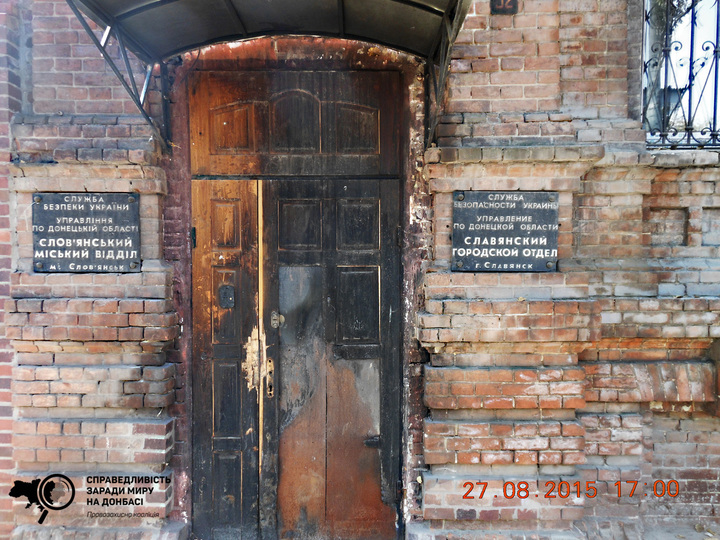
The seizure of Slovyansk by pro-Russian separatists led by Igor Strelkov (Girkin), a Russian citizen, was the starting point of the anti-terrorist operation launched in response by the Ukrainian government. Slovyansk then became a stronghold for the advances of the ‘DPR’ militants. A local businessman Vyacheslav Ponomaryov appointed himself as a ‘city mayor’.
Ponomaryov urged people to tell the ‘people’s militia’ about ‘suspicious’ individuals, particularly Ukrainian speakers, banned the political parties Batkivshchyna, UDAR, and Svoboda, and called upon Russia to bring peacekeeping forces. The ‘suspicious’ individuals were jailed in the basement of a seized State Security Service (SSU) building, at the temporary holding facility of the city police station, as well as the fire station of Artem village.
Reasons for detaining people included denunciations, curfew violations, photography, a suspicion of pro-Ukrainian views, or even the infamous Stalin’s ‘article 58’.
Among people held captive in Slovyansk, there were 40 Ukrainian and international journalists, including Simon Ostrovsky (VICE News), Serhiy Lefter (a journalist with the Open Dialogue foundation in Poland), Yevheniya Suprycheva (Komsomolska Pravda in Ukraine), citizen journalist Artem Deyneha, a journalist from Kolomyia Yevhen Hapych, Italian journalists Paul Gogo and Kossimo Karl Marx Street 32, Slovyansk, Donetsk region, Ukraine, 84100
Attnasio, Dmytro Halka (Belarus newspaper ‘Novy Chas’), Buzzfeed reporter Mike Giglio and Olena Hlazunova, a volunteer from Donetsk, as well as television crews from Skynews and CBS.
Many of them were detained at the SSU basement.
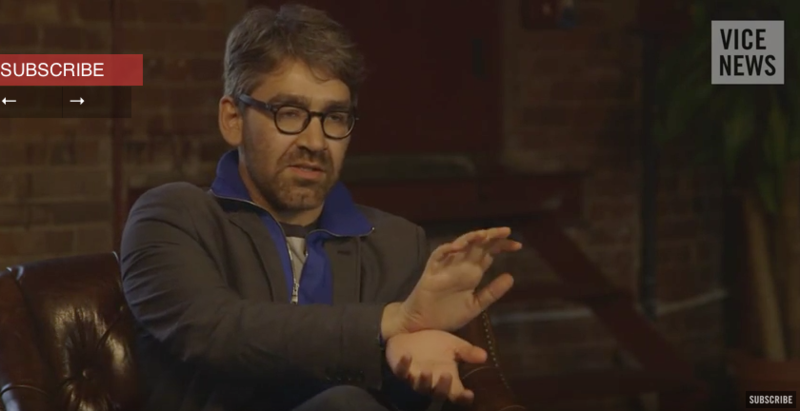
On 21 April, Simon Ostrovsky (photo above) was kidnapped, blindfolded, tied up with tape and beaten. He spent 4 days in the SSU basement.
According to Simon, the militants tried to make the first night as unbearable as possible - someone came, assaulted and threatened every half an hour. The US government urged Kremlin to release the American citizen.
When I refused to give the password to my laptop, I was smacked in the arm with a truncheon. When I was asleep on the floor, masked men came to wake me up and tell me how no one would miss me if I died, and then kicked me in the ribs as they left.
Serhiy Lefter is talking about his experience as a prisoner
Of course [they] were beating people. During interrogation. I was interrogated on the 18th. I was present at the interrogation of Vitaliy Kovalchuk and two guys from the Right Sector. They admitted they were members of the Right Sector. Later, they were found dead.
Yevhen Hapych (photo below) was held captive for two days with his eyes blindfolded and hands tied during that entire time. He was kept separately.
They used physical force during interrogation. One man who called himself ‘a Berkut guy’ was particularly cruel. He promised to send me to ‘the Heavenly Hundred’. He scratched my neck with a knife leaving a scar.
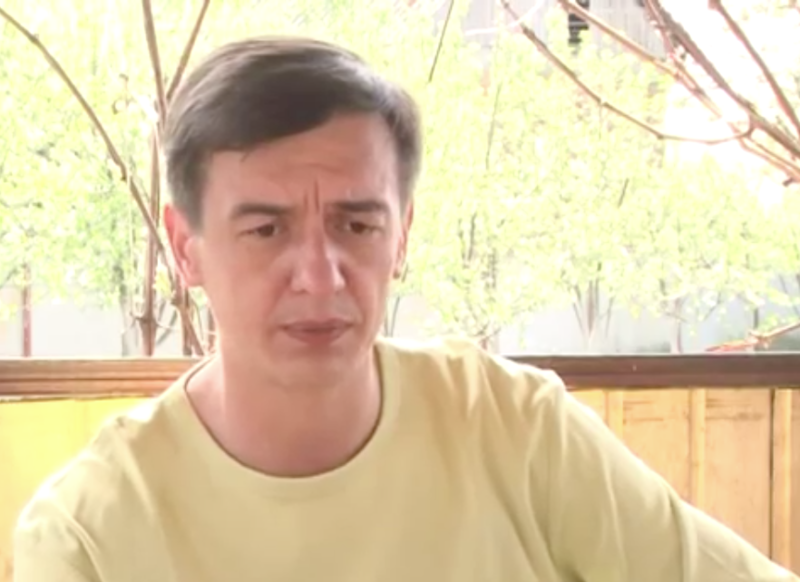
In addition, on 25 April, the militants captured the OSCE observers and were holding them at the SSU basement with blindfolds on their eyes and their hands tied. The prisoners were released on 3 May following an intervention by Volodymyr Lukun, Putin’s representative. One of the prisoners, a Czech observer Josef Prerovsky said that the gunman threatened to use the hostages as ‘human shields’.
According to the victims, the SSU basement was dirty and cold even though the temperature outside reached 15-18 degrees. The air was stale. In the rooms with windows it was possible to open window panes for ventilation, but it was often prohibited as they wanted to prevent the prisoners from hearing the guards' conversations in the street. There was a light bulb in the hallway, and it was not allowed to turn it off. However, it did not dissolve the darkness.
'If the room was big, it accommodated 15-16 people. The smallest room, which had no windows, was approximately 4x4 [meters] in size and could fit 10-11 people. In general, there were three rooms in one part in the basement, and another one at the storage area, where they also kept people. From what I know, there could be 20 people at the basement during one day', says journalist Lefter.
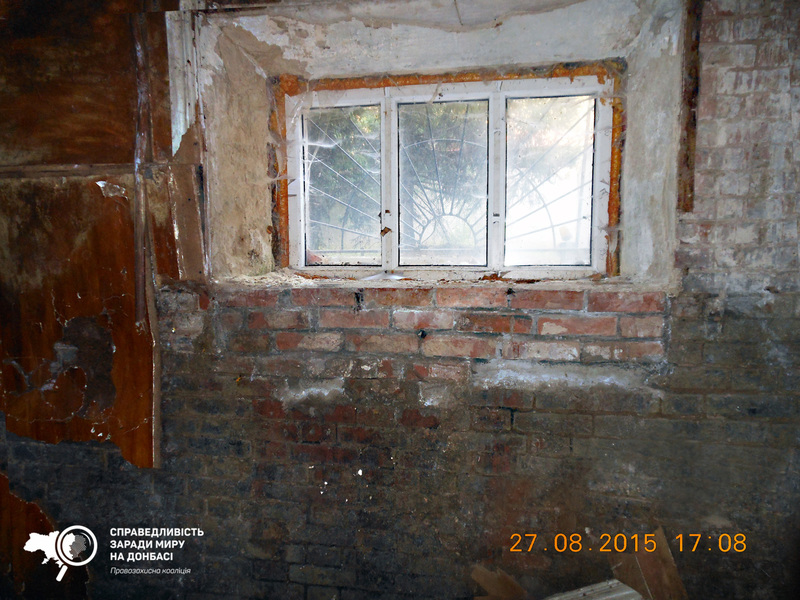
Prisoners were fed twice a day with porridge, a piece of sausage or cucumber. However, victims say it was not enough. Prisoners could only get water when they were taken out, or drink water from a makeshift sink - a plastic bottle. However, in general, there was a lack of water. They urinated into a five-liter bottle, for other needs, they had to ask the guards to take them out of the cell for a long time.
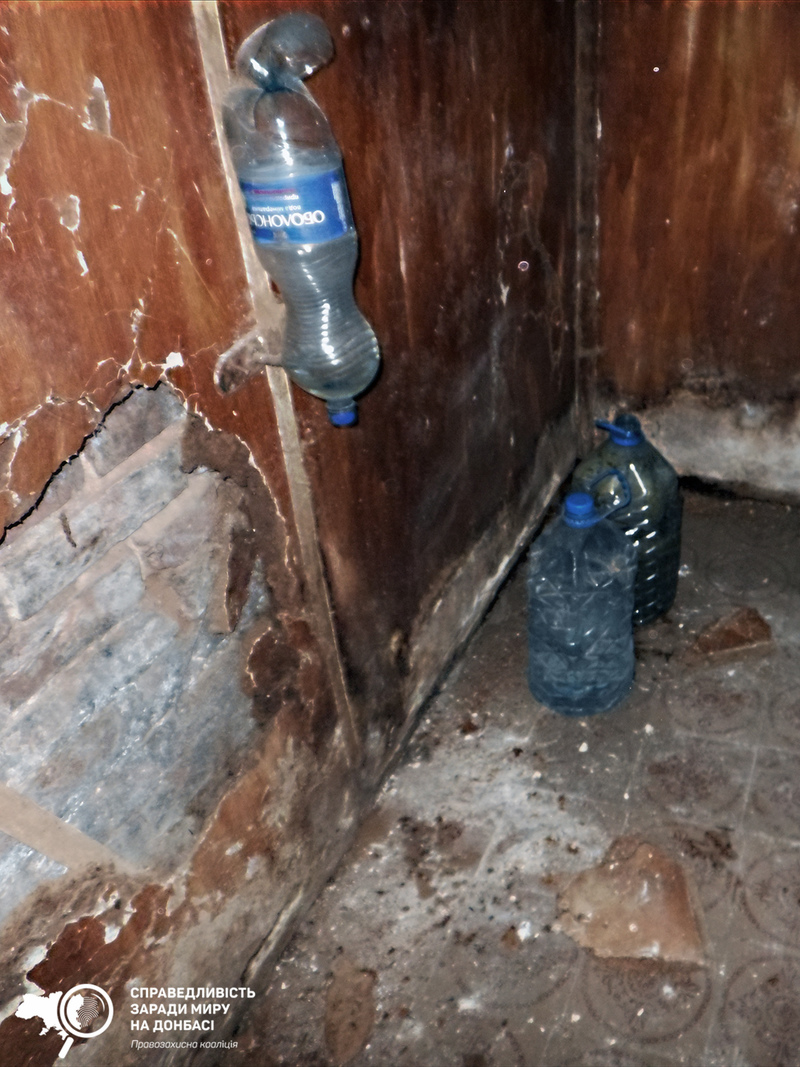
Former prisoners say they were not allowed to sleep, especially at night. They could take a nap during the day, but at night the guards came and used stun guns and truncheons on those who had fallen asleep. Some prisoners were not even allowed to lie down, only to sit. They had to lie on a concrete floor with a sack or a cloth under their body at best. It was also prohibited to talk to each other.
Prisoners were sometimes taken to perform forced labor, make fortifications, dig trenches, or clean the territory.
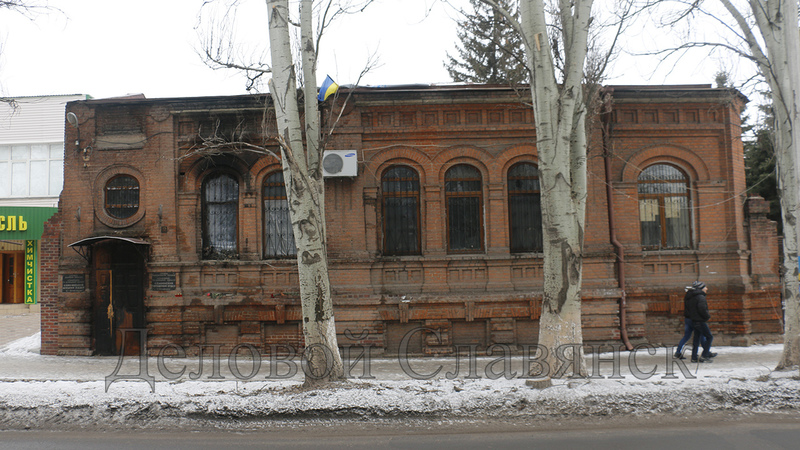
The SSU building in Slovyansk. Source
The militants blindfolded the majority of people (put tape on their eyes or a sack over their heads), tied their hands, and, sometimes, feet. Some people would spend days tied and blindfolded.
They were constantly abusing prisoners, both physically and morally, including beating them with their hands, feet, and truncheons, using stun guns and buttstocks, knocking their teeth out, piercing with an awl, cutting with a knife, using a drill, depriving them of sleep, performing mock executions, and threatening. People left the basement with teeth knocked out, broken ribs, and multiple bruises. There was no medical care for prisoners.
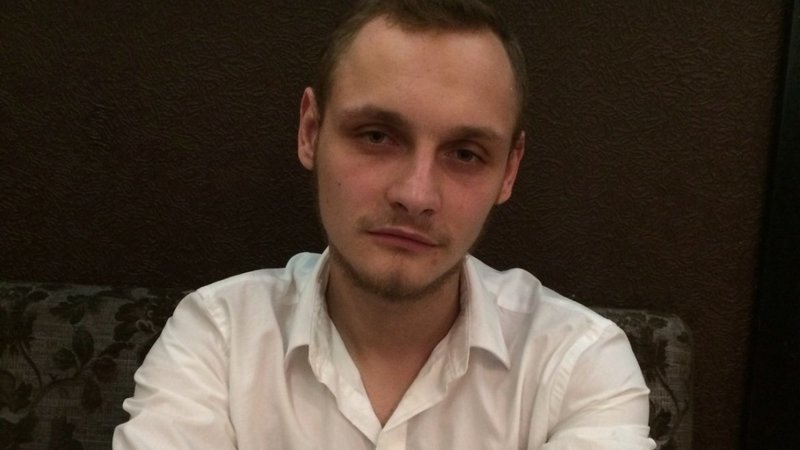
Vitaliy Kovalchuk survived cruel torture (photo above was taken soon after his release) and witnessed the last days of Volodymyr Rybak, a deputy from Horlivka, and two men from the Right Sector - Yuriy Popravka and Yuriy Dyakovsky. Vitaliy came to Slovyansk with the two men to learn about the situation. The friends quickly found out that the circumstances were way more serious than they had imagined. According to Vitaliy, people at the SSU basement cut off Dyakovsky's finger, took his scalp, and put a hat on his head. In addition, they injected a substance causing severe pain into his shoulder. They pierced Popravka's cheek and foot with a an awl. Vitaliy said that Rybak and another man were beaten to death at the SSU, and their bodies were removed. Dyakovysky and Popravka were transported from the basement while they were still alive. Then, all four bodies were found in a river with their stomachs ripped open.
Kovalchuk describes how he was tortured:
They put a trash bag on me and tied it around my neck. When they hit you, you suffocate, of course, and feel dizzy. I understood I would die.
… They put me on my stomach, tied my hands and feet behind my back, and put a knife into my back. They liked when they cut a bone because they made a crack in the rib, and then turned the knife to make the crack wider.
They knocked out my jaw. They did not break my nose, but I couldn’t breathe for the first two weeks. They dislocated my fingers so they were pointing to different directions. At first, I thought they were broken, and my hands were all swollen. They jumped on my hands and my body.
‘They were sticking an awl into my stomach, and piercing my feet with it’, says Yaroslav Malanchuk who was kidnapped for taking part in preparations for presidential elections and taken to the SSU basement in Slovyansk.
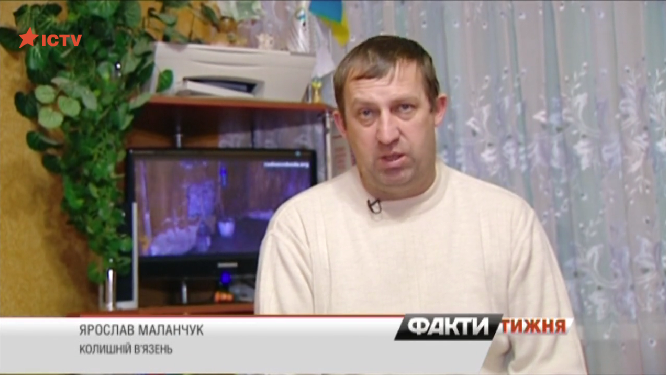
A former prisoner Vladyslav Marko took ICTV reporters around the basement:
On average, there were 14-20 people on the basement, but people would change. They tortured people in rooms with rubber floors. They threw me here, and it was pitch-black, impossible to see anything. I looked and saw blood everywhere, walls were all covered in blood. I heard a woman screaming from that side. They were torturing here - she was wailing in a voice not her own… Everything here was covered in cloth soaked with blood, blood stains, there is blood here. I can tell you that many people were killed here; it was not just one person...
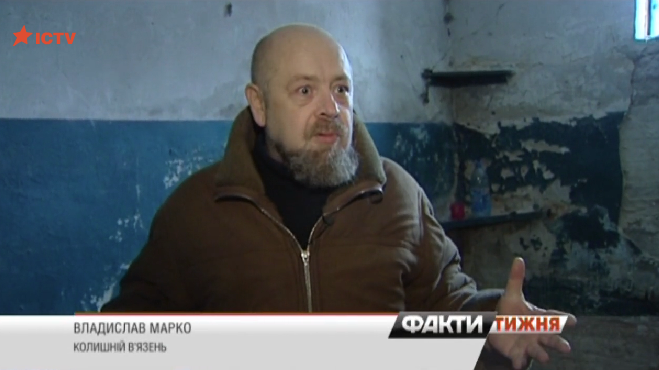
Hennadiy Lysenko, member of the ‘Good News’ church, describes how he was tortured in the SSU basement. They hit his ribs and back with a knife-bayonet, which left no cutting marks but was extremely painful. According to the victim, a man with a Russian accent known as ‘Osobist’ tortured him.
There are reports about executions in Slovyansk during the time of its occupation by the ‘DPR’ formation. For instance, TSN reporters showed protocols of execution of Oleksiy Pichko, a local who had stolen trousers and shirts from his neighbour’s house. There is also an interview with his mother. The execution took place in the backyard of the SSU building. There are also documents on the execution of Vitaliy Solovyov, a person with 2nd degree disability.
Igor Strelkov-Girkin himself confirmed there had been executions in Slovyansk.
‘We had courts-martial and introduced the 1941 legislation enacted by Stalin. We were judging and executing in accordance to this legislation… There were four people executed during my stay in Slovyansk… Two servicemen [were executed] for looting, one local man - for looting, and one man was executed for killing a soldier, he was a principled Right Sector affiliate’.
Igor Druz, Strelkov’s advisor, also confirmed the use of executions in an interview with the BBC.
One of the most known tragic cases was the murder of four protestants. On 8 June, gunmen for the ‘Russian Orthodox Army’ stormed into the church of evangelical Christians ‘Transfiguration of Christ’ and captured deacons Volodymyr Velychko, Viktor Bradarsky, and two sons of the senior pastor, a 30-year old Ruvym Pavenko and 24-year old Albert Pavenko. On the following day, after torturing the prisoners (possibly at the fire station of Artem village), they executed them. An article in ‘Focus’ describes the cruel details of the execution. The victims’ families founds out about their fate only a month after it had happened, following the liberation of Slovyansk and discovery of their graves.
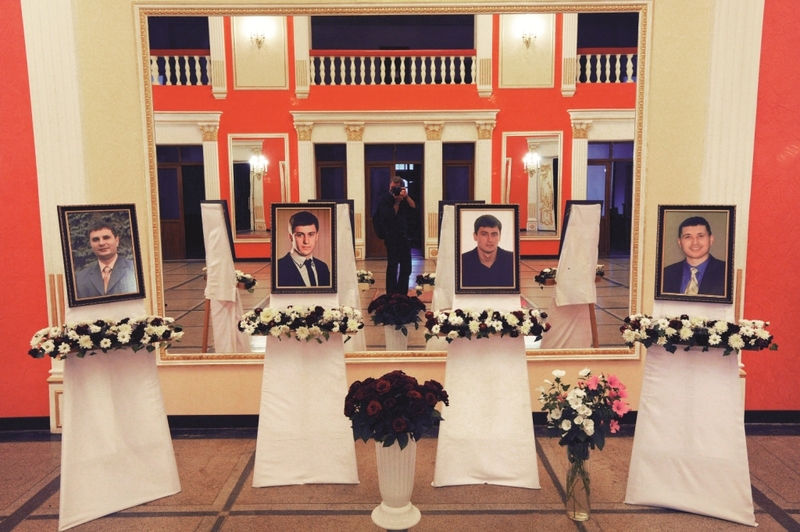
Photo (left to right): Volodymyr Velychko, Albert Pavenko, Ruvym Pavenko, Viktor Bradarsky. Source

Photo: Suspilne On September 15, human rights activists held campaigned near the Verkhovna Rada of Ukraine requesting adopton of the...

53% of Ukrainians believe that only those persons whose guilt in war and other serious crimes will be proven in court should be pros...

More than 100 mercenaries from more than 30 countries are fighting on the side of illegal armed groups in Donbass. Deputy Prosecutor...
The Secretariat of the Coalition «Justice for Peace in Donbas»
04060, Kyiv, Ryzhska str., 73 G